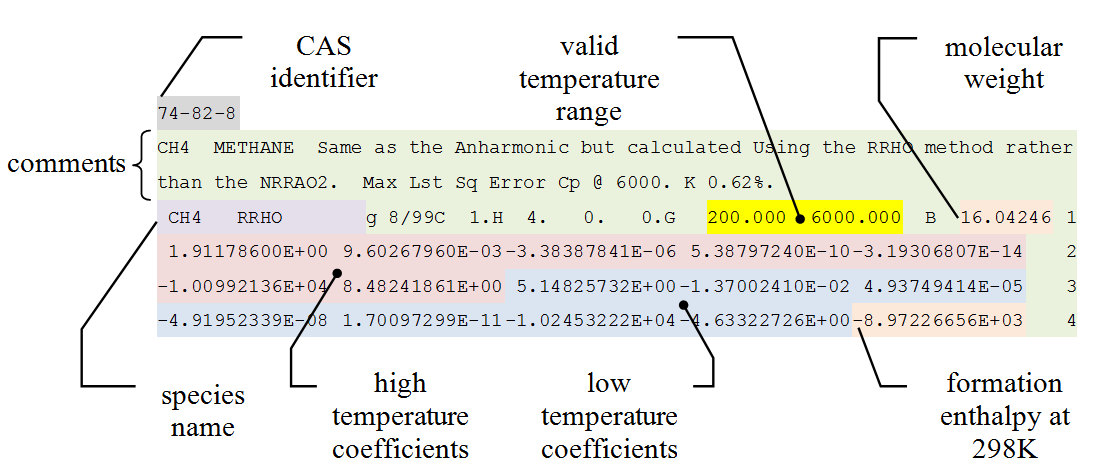12.1.16. Thermochemical Properties¶
MFiX uses the Burcat or NASA 7-Coefficient polynomials to calculate
thermochemical properties of species (not the NASA 9-Coefficient
polynomials). The directory model/thermochemical contains the database of Burcat and
Ruscic (2005) and routines for reading the database. With linkage to this
database the users need not manually enter data for molecular weight, specific
heat, and heats of reactions. Instead the users only need to enter the names of
the species (keyword SPECIES_g and SPECIES_s) in the data file. If such
information is already provided in either the data file or a BURCAT.THR file in
the run directory then MFiX will not reference the database. That is, MFiX reads
the necessary thermochemical data from files in the following order:
mfix.dator*.mfxBURCAT.THRfile in the run directorymodel/thermochemical/BURCAT.THR
The species names are case sensitive and should match the names in
BURCAT.THR exactly; alternatively aliases can be defined for common species,
such as O2, in read_therm.f. See tests/thermo for a sample case that
accesses the database. The format of BURCAT.THR file resembles CHEMKIN
format, but with several notable differences. To include thermochemical data in
the mfix.dat file then this information must start below a line that starts with
THERMO DATA.
Example dataset from BURCAT.THR with notations:

Each entry in the database starts with a unique CAS identifier (74-82-8) for the species, followed by several lines of comments highlighted in green. The data section starts with the species name in columns 1-18 (CH4 RRHO). Common species names may be followed by strings (RRHO) that identify the method used to determine the coefficients. Additional information follows the species name. The numbers toward the end of the line are the temperature limits (200.000 6000.000) in degrees Kelvin where the property calculation is valid and the molecular weight (16.04246). Unlike CHEMKIN the common temperature for the high and low temperature branches are not recorded; it is always 1000 K. The next three lines give the fourteen coefficients (seven coefficients each for the high and low temperature branches) and the formation enthalpy at 298 K (which is also not included in CHEMKIN format). All the coefficients and the enthalpy of formation are normalized with the gas constant R (cal/mol/K). The low temperature coefficients (\(a_L\)) should be used for temperatures in the range Tlow to 1000K and the high temperature coefficients (\(a_H\)) should be used for temperatures in the range 1000K to Thigh. The coefficients are stored in a fixed format (E15.0) as follows:
\(a^1_H\) |
\(a^2_H\) |
\(a^3_H\) |
\(a^4_H\) |
\(a^5_H\) |
\(a^6_H\) |
\(a^7_H\) |
\(a^1_L\) |
\(a^2_L\) |
\(a^3_L\) |
\(a^4_L\) |
\(a^5_L\) |
\(a^6_L\) |
\(a^7_L\) |
\(\frac{\Delta H^{\circ}_f}{R}\) |
where \(\Delta H^{\circ}_f\) is the formation enthalpy at 298K.
The normalized specific heat is given by
The coefficients \(a_6\) and \(a_7\) are not required to calculate \(C_p\). They are used in the \(H_T\), \(S_T\), and \(G_T\) polynomials which are not used by MFiX:
Instead, MFiX integrates \(C_p\) to determine changes in enthalpy. See
Burcat Introduction
document for more details, which is also included in the source,
model/thermochemical/intro.pdf.
Additional database comments:
A number of species in the database have a lower temperature limit of 300K which is 2 degrees above the reference temperature (298 K) used for formation enthalpy calculation. For those species MFiX relaxes the lower limit for \(C_p\) calculations to 298 K to enable heat of reaction calculation (see read_database.f).
The database reader is set up such that the database is read only if necessary.
If you include thermochemical properties in mfix.dat all keywords defined below the line that starts with THERMO DATA will be ignored!